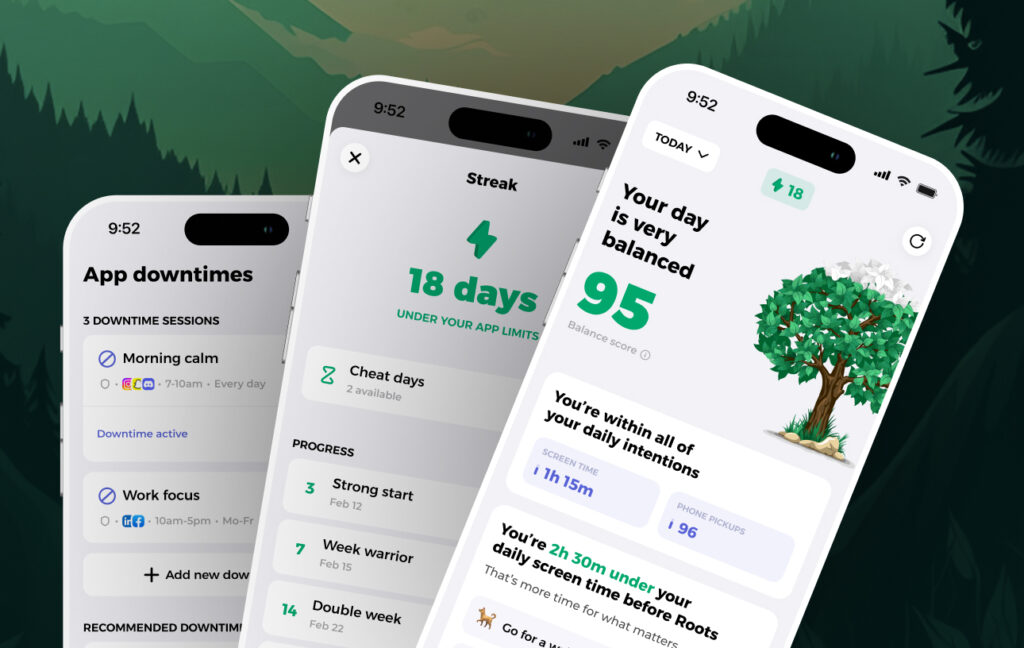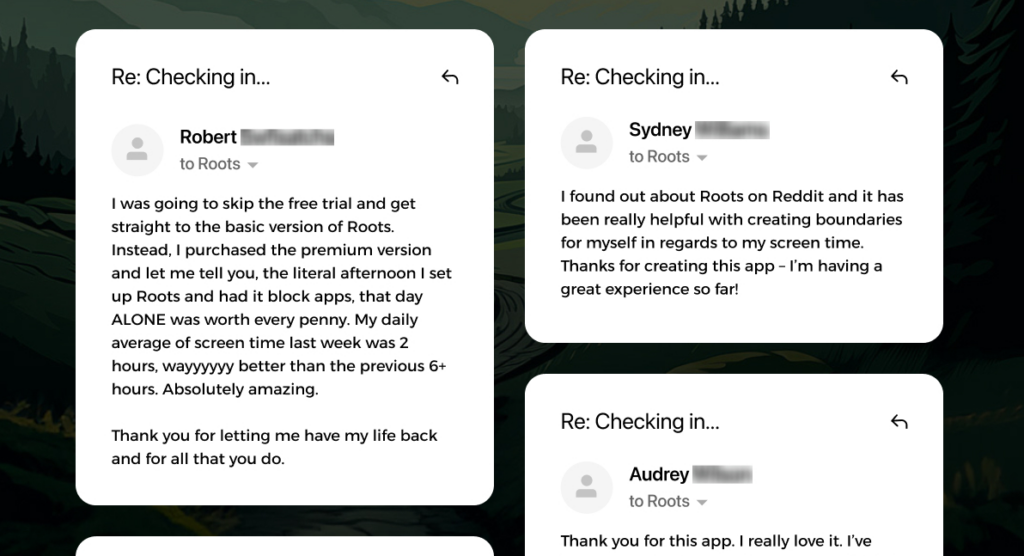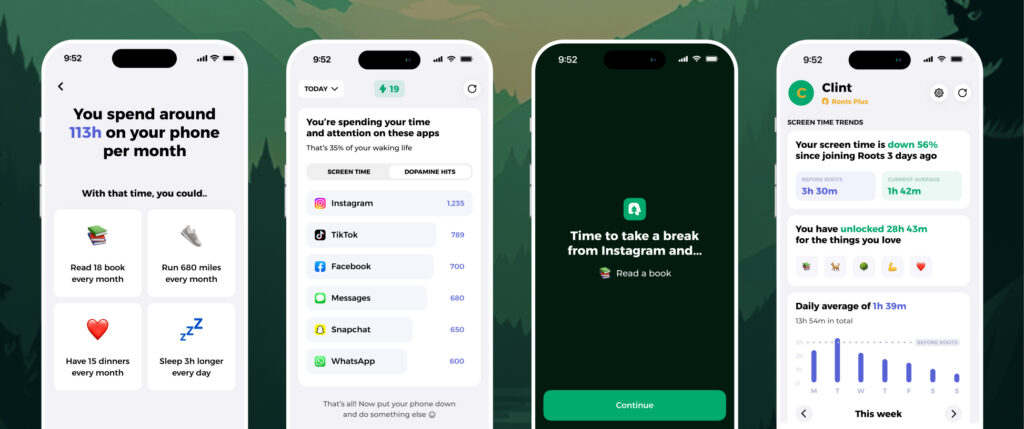Welcome to this edition of our Tools for Thought series, where we interview founders on a mission to help us think better and live happier. Clint Jarvis is the founder of Roots, a mobile app designed to set boundaries with your phone and make time for the things you love.
In this interview, we talked about how to find balance in the digital world, how to build an intentional relationship with technology, how gamification can help us stick with our intentions, and much more. Enjoy the read!

Hi Clint, thanks for agreeing to this interview! You’re on a mission to help us live a balanced life in a digital world. What does that mean exactly?
We live in a very digital world where we are more “connected” than ever before. This has some amazing benefits, but it also comes with some big downsides. The 2024 Oxford Word of the Year was “Brain Rot”. I think this is a strong signal of how people feel about living in our hyper-connected world.
For us, finding balance is about intentionally building a healthier relationship with our digital devices and setting clear boundaries. This applies to all technology, but I think phone usage is the most acute and addressable problem. Studies show that over 50% of us are addicted to our phones, and I suspect the real number is higher.
The average person spends over 6 hours per day consuming content, and checks their phone around 150 times… that’s every 6 minutes. When you add it all up, we touch, tap, or scroll on our phones 2,617 times per day.
For most of us, this was not a conscious choice. We just woke up one day and realized that our phones were stealing our time, attention, and energy. And it has a major impact on our mental and physical health. Excessive phone usage leads to an increase in anxiety and depression, neck pain, and sleep disturbances… shorter attention spans, less time outside, less time with loved ones… the list goes on and on. You’ve probably seen the infamous chart that shows how mental health problems spiked the year of the first iPhone launch.
So, we have found ourselves in a position where things have gotten pretty out of balance when it comes to our relationship with technology.
But this is not about demonizing technology, right?
That’s a great point. We love technology. When used intentionally, it really can make our lives better. And, it’s not going anywhere. We are not suggesting that you get rid of your phone, or avoid technology completely.
But, if we continue on our current trajectory, we could end up living in one of those near future dystopian movies where everyone is plugged into virtual reality 16 hours a day. It feels like an important moment for us to take a step back and reassess what it means to use technology thoughtfully,
It’s really about building a balanced relationship. We believe it’s possible to use technology to its fullest potential without compromising your wellbeing.

So that’s what inspired you to create Roots.
That’s right. I’ve experienced this problem first hand. When I was building my first startup, I reached a point of serious burnout. I was working 7 days a week, and in a self-imposed way, I was never disconnected. I checked slack and email 24/7, and filled every gap in my day with my phone.
My brain was always wired, I struggled with sleep, I was having back issues, and generally was not very happy on a day to day basis. And I was only 25 years old. I took a long look in the mirror, and decided it was time for a change.
I started taking small steps towards finding better balance in my life. It wasn’t just about screen time or my phone, but taking a fresh look at everything I was doing. That was about 10 years ago and was the start of a journey towards finding better personal balance. It’s still a work in progress and I imagine always will be.
Around 3 years ago I started to get the urge to build something that could help other people find better balance in our digital world, but I didn’t know what it should be. At the time I was building my second startup, Intown Golf Club, which was growing fast, we went from zero to #205 on the Inc. 5000 list over the last 5 years. Despite the success of Intown Golf Club, I felt a strong pull towards building something new. I started working weekends on a few ideas.
Two years ago, we launched the first version of Roots — a nature-based mindfulness app — as a side project. After talking to a lot of our users, I realized that we were building something that was “nice to have”, not “must have”. But, during those conversations I started to see a pattern. People talked about how their phones were getting in the way of everyday life. This resonated strongly with my own experience.
I joined a startup studio with Wildwood Ventures to explore what Roots could become. I came in with several broad ideas, but we honed in on phone addiction pretty quickly. Everyone we talked to had a similar story — the paradox of “I don’t have enough time”, and “I spend 4+ hours per day on my phone”. It felt like there was a real opportunity to unlock this time.
It was clear that people needed help keeping their mindless scrolling in check, and they didn’t have a solution — they either weren’t aware of the native phone limits, or found it too easy to ignore them.
We believed we could build a brand that promoted better balance, and create an app that acted like a friendly accountability partner with app blocking that had more friction, so you could actually stick to it.
Even with a clear vision, the path is a winding one. There was actually a point in the journey where we almost quit. In early 2024, we had just launched our beta version of the app, we were struggling with the Apple Screen Time API, we were almost out of cash, and it felt like everything was an uphill battle. The voice in my head started having doubts. I specifically remember going for a walk in my neighborhood to clear my mind and decide whether we should keep moving forward.
I saw 5 people on the walk. Two kids walking to the bus stop, a mom pushing a stroller, a grandparent in the park, and a man running. Every single one of them was distracted and on their phone. It felt like a sign from the universe. I went home, and decided to commit to the next phase, which included making a personal investment in our pre-seed round to extend the runway.
We made a ton of progress over the next 6 months. In October, it felt like we turned a corner. I send a personal email to everyone who signs up. For a long time, I rarely got a reply. If I did, it was usually about a bug or potential improvement. Then, I started getting love letters. Lots of them. We track a lot of KPIs, but this one is probably my favorite.

So, how does Roots work, exactly?
Roots works like a friendly accountability partner. We give you tools to set hard limits, offer encouraging nudges, and help turn data into actionable insights.
We start by setting your intentions — how much time do you want to spend on your phone? How often do you want to check your phone? What kind of limits and downtimes do you want to adopt? And, importantly, what are the simple things you can use as “scroll replacements”? It’s easier to cut back on doom scrolling when you have something to replace it with.
Then we help you set up a personalized combination of app limits and downtimes. One of our most popular blocking features is “Monk Mode” which keeps you from unblocking apps completely. Another popular blocking feature is “Intentional Mode”, which keeps apps blocked by default and forces you to unblock mindfully for each session. We think it’s important to offer a flexible set up since everyone has a unique relationship with their phone.
We also include a small dose of gamification. We have a beautiful tree for you to keep healthy by staying within your intentions. As you stay under your limits and downtimes, you’ll build a streak, and you can earn cheat days and custom app icons as you go.
We take boring screen time data and make it interesting. The “Daily Balance Score” is like a sleep score for your phone. We break down app usage using our patent-pending “Digital Dopamine Tracker”, which helps quantify the impact of time on each app, since not all screen time is equal. We show you “how often you check your phone” instead of just pickups, and much more.
Finally, we help you quantify progress and encourage you to keep it up by showing you how much time you’ve unlocked by using the app, and progress over time.

Another interesting feature is challenges. Can you tell more?
This is one of my favorite features. The idea is to host time-based phone detox challenges that anyone can join. The beauty of it is, the app will track everything automatically and keep you accountable. Plus, you can invite friends or family to join and make it a social thing.
We have hosted everything from a “Sunday Social Media Detox”, to “Be Present for Thanksgiving”. We typically will host a few unique challenges per week. All of them involve blocking your most distracting apps for the day, and only allowing a few unblocks.
There is something special about the community aspect of Challenges. It’s fun to know that you’re in it together. Even for our team, on Monday’s, it’s always exciting to share stories from the Sunday Detox Challenge.
Challenges are also a great way to get “back on the horse” if you fall out of your daily blocking habits. We’ve heard from many users that they will use a Sunday Detox Challenge as a way to kick things back off when they start to slip.
What kind of people use Roots?
It’s funny, part of the playbook when you build an early stage company is to “start narrow.” Meaning, you should have a single focus on a specific type of user.
We started with this goal in mind, but as we went along we realized that Roots works really well for many several different types of people.
Professionals (both remote and in-office) are a big one. Folks who are tied to a screen for work and want to set boundaries so they can be more productive, and enjoy real downtime.
Parents use Roots to be more present with their family, and to set better examples for their kids. Students use Roots to stay focused on studying, and help with anxiety and mental health. Couples use Roots to be more present in their relationship, and join challenges like “phone free date nights”.
The beauty is that many types of people use Roots to boost productivity, unlock more time, improve wellbeing, be more present, strengthen relationships, and get better sleep. The average person on Roots is unlocking two hours every single day.
What about you, how do you use Roots?
I use Roots every day. I averaged 4 hours per day on my phone before Roots. Now I’m consistently under 2 hours per day. My pickups have gone from 150 per day down to 50. But, if I’m testing something new and delete my regular setup, it’s a slippery slope. I find myself creeping back up towards 4 hours per day very quickly. I’ve found I really need the guardrails.
I use it in a few different ways. First, I have a weekly set of blocking rules. I keep all social media and work apps blocked in the morning (4:00AM – 9:00AM) and evening (6:00PM-4:00AM). In the morning I give myself 2 unblocks, so I can check in on the day, without doom scrolling my morning away. In the evening, I use “Monk Mode”, so I can’t unblock even if I want to. This helps me wind down at night and keeps me off my phone in bed. If I really need to get online I’m forced to be intentional and use my computer.
Outside of my downtimes, I keep social media blocked by default and only allow 5 unblocks per day. This has made a big difference. It’s only a small amount of friction to unblock, but it forces me to think twice each time.
I set up my “scroll replacements” to be reading, stretching, going outside, and walking my dog. Each time I want to unblock an app, I’m forced to look at the list of things I could be doing instead. My dog gets a lot more walks than she did before I started using Roots.
In Roots, we show you “how often you check your phone”. So I keep a close eye on my pickups and try to stay above “every 20 minutes”, which is around 50 pickups per day. I do our weekly “Sunday Social Media Detox” challenge, this serves as a nice reset each week. I will usually take a few minutes on this day to review the prior week and see which apps I consumed the most “digital dopamine” from, check my balance score, and assess my plans for the coming week so I can adjust as needed.
Every month or so I will go phone-free by turning on Monk Mode for 24 hours. The first time I did this I was shocked by how good it felt. I hadn’t stayed off my phone for 24 hours since I got my first iPhone in high school in 2008. By the end of the 24 hours, I honestly felt like time had slowed down and I was more at peace than I had been in a long time.
And finally… What’s next for Roots?
We are very bullish about the future. I believe everyone who has a phone can benefit from Roots. It feels like the screen time space is in a similar position to where meditation apps were in 2015. Headspace and Calm were early in their journey, and over the next 10 years we would see several unicorns emerge and hundreds of millions of people start using meditation apps.
2025 will be all about growth. We have worked very hard this year to iterate quickly, and set the app up to be very scalable. We have several exciting marketing activations kicking off in the new year.
I expect the team will grow quickly. We currently have 4 full time co-founders, and several key part-time team members. I am very proud of our founding team. We have an amazing culture where everyone is excited about what they are doing on a daily basis.
On the product side we have a lot of exciting things planned for Q1 2025, and beyond. We are a very design focused team. We are obsessed with continuing to iterate the app, and building it into the best possible product it can be. We still have a long way to go to realize our vision, but we’re already helping people change their lives with the current version.
We aim to be the category winners of the screen time space. Our goal is to help 100,000,000 people build a better relationship with their digital devices in the next 5 years. I truly believe we can help change the world, and the way we live with technology.
Thank you so much for your time, Clint! Where can people learn more about Roots?
Thank you for all the great questions! You can learn more on our website, or jump right in and download the app. Follow us on Linkedin, Instagram, or Twitter (X), where we share insights and product updates. And, if you’re up for a challenge, join us for a Sunday Social Media Detox this weekend!
